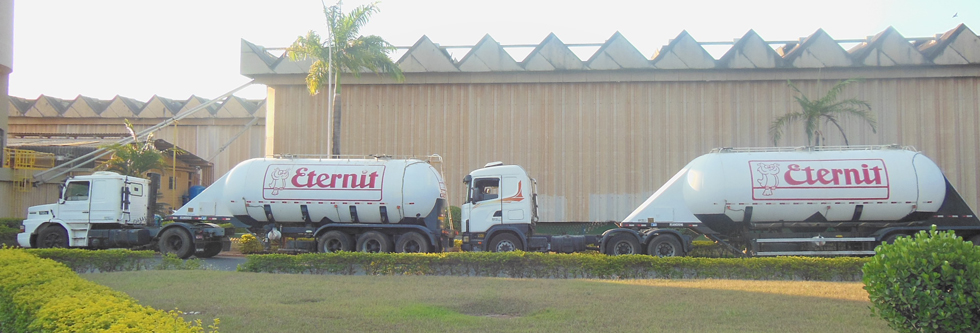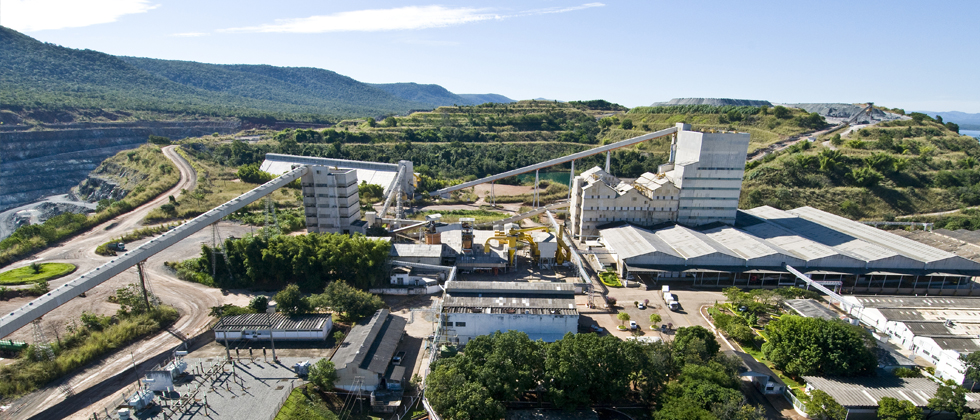Eternit believes that effectively managing the risks inherent to its operations gives it a competitive advantage in the market. The Company’s practices include regularly analyzing the risks to which it is exposed and that could adversely affect its business, financial condition and the results of its operations. These practices are supported by the Internal Control and Internal Audit areas and also by the Audit, Financial Control and Treasury Committee of the Board of Directors. The day-to-day activities of the operational, labor, environmental, community and investor relations areas are overseen by experts from a wide range of fields through a multidisciplinary effort that identifies and addresses the risks of each area.
Alert to potential changes in the country’s economy that could affect job creation, income distribution, credit availability and consumption, Eternit has implemented the Structured Expansion and Diversification Plan (see more information in the chapter Strategic management). The plan expands the portfolio of solutions available to the Company and, combined with the effective monitoring of risk factors, can mitigate the effects on sales in the event of any reduction in purchasing power and decrease in consumer confidence by strengthening the brand among clients, consumers and the market.
Preserving the health and safety of its employees is one of Eternit’s core principles. To prevent accidents and reduce operational risks, the Company follows occupational safety standards, offers collective protection devices and requires the use of Personal Protective Equipment (PPE). Safety Committees and Fire Brigades installed at all plants further encourage the participation of employees in preventing accidents.
These safety measures have yielded solid results for the Company. For the second consecutive year, SAMA did not record any lost-time injuries. The Tripartite Agreement (see more in Safe use of chrysotile asbestos) gives employees the autonomy to halt production in the event of any risk to health or safety. The mining company and the fiber-cement production units are supported by an Inspection Commission that monitors compliance with the Agreement as well as with the legal requirements related to the Internal Accident Prevention Commission (CIPA). GRI LA9
The lost-time injury frequency rate of the Eternit Group in 2013 was 10.48, compared to 8.14 in the previous year. Meanwhile, the severity rate was 279.66, compared to 497.41 in 2012. All incidents are recorded and reported in accordance with the rules of the International Labor Organization (ILO). GRI LA7

| Occupational injury, illnesses, lost days, absenteeism and fatalities, by region GRI LA7 | |||
|---|---|---|---|
| Operating unit | Man hours worked | Lost-time injuries | Lost days |
| Colombo | 745,537 | 9 | 78 |
| Anápolis | 277,447 | 5 | 90 |
| Rio de Janeiro | 387,239 | 6 | 39 |
| Goiânia | 636,474 | 11 | 283 |
| Bahia | 472,076 | 12 | 272 |
| Subtotal | 2,518,773 | 43 | 762 |
| Tégula Atibaia | 516,701 | - | - |
| Tégula Içara | 127,703 | 1 | 15 |
| Tégula Camaçari | 92,193 | 3 | 25 |
| Tégula Frederico Westphalen | 88,572 | 1 | 15 |
| Tégula Anápolis | 118,933 | 1 | 305 |
| Tégula São José do Rio Preto | 78,891 | 3 | 14 |
| Subtotal | 1,022,993 | 9 | 374 |
| SAMA | 1,421,415 | - | 252 |
| Total | 4,963,181 | 52 | 1,388 |

Preserving the health
and safety of its
employees is one of
Eternit’s core principles
| Employees represented in formal health and safety committees GRI LA6 | ||||||
|---|---|---|---|---|---|---|
| 2013 | Internal accident prevention commission |
Asbestos commission | Fire brigade | Total employees in committees |
Total employees | % |
| Colombo | 9 | 4 | 30 | 43 | 310 | 13.87 |
| Simões Filho | 14 | 5 | 20 | 39 | 197 | 19.80 |
| Anápolis | 14 | 4 | 40 | 58 | 108 | 53.70 |
| Rio de Janeiro | 14 | 4 | 39 | 57 | 181 | 31.49 |
| Goiânia | 14 | 5 | 46 | 65 | 293 | 22.18 |
| SAMA - Minaçu | 10 | 10 | 64 | 84 | 702 | 11.97 |
| 2013 | Internal accident prevention commission |
Safety committee + golden hand | Fire brigade | Total employees in committees |
Total employees | % |
| Tégula Atibaia | 14 | 12 | 15 | 41 | 221 | 18.55 |
| Tégula Içara | 8 | 5 | 9 | 22 | 60 | 36.67 |
| Tégula Camaçari | 4 | 4 | 6 | 14 | 42 | 33.33 |
| Tégula Frederico Westphalen | 7 | 7 | 11 | 25 | 38 | 65.79 |
| Tégula São José do Rio Preto | 4 | 4 | 10 | 18 | 36 | 50.00 |
| Tégula Anápolis | 8 | 13 | - | 21 | 52 | 40.38 |
Environmental risks are identified through the management system of the ISO 14001 standard. Once a risk is detected, mitigation plans are formulated based on the guidelines. Eternit invests in continuous monitoring to prevent the occurrence of such incidents: aspects such as airborne particles and gas emissions, as well as the results of waste disposal, water reuse, reforestation of mining slopes and others are audited on a semiannual basis at all units. At SAMA, the programs in this area are monitored by experts and provisions have been accrued for potential environmental liabilities.
By acting responsibly with regard to its financial obligations, Eternit avoids any risks of this nature. Some of the measures adopted include maintaining low levels of debt and not contracting any transactions leveraged by derivate instruments that are of a speculative nature.
The Company considers its credit risk to be low, thanks to its broad client base and rigorous credit-approval mechanisms. The Credit Manager tool automates the process and supports the decision-making process, which facilitates the acquisition of new clients and helps ensure profitability.
When needed, the company enters into Advances on Export Contracts (Ace) and Forward Foreign Exchange Contracts (ACC) to hedge its portfolio of foreign clients. Provisions accrued as a result of past events are reported on the income statement net of any reimbursements.
Brazil’s production chain safely uses chrysotile asbestos. Therefore, before addressing the risk of restrictions, we must first understand the issue.
The asbesto mined in Brazil known as chrysotile asbestos fiber, or white asbestos, is a hydrated magnesium silicate belonging to the serpentine group of minerals. Its composition does not pose significant risks to human health at levels of exposure of less than 2 fibers/cm³ and its fibers also have a low level of biopersistence. To guarantee the health of its employees, Eternit operates with maximum concentrations of 0.1 fibers/cm³, which is 20 times lower than the legal tolerance limit. It is naturally difficult for chrysotile asbestos to separate from a fiber-cement product, since its fibers comprise only 10% of the material and are very strongly bonded to the cement matrix given its affinity with cement, which is also a type of silicate.
Even so, the Company constantly measures the concentration of fibers in suspension at its mines and plants. In addition to opening its doors for a semiannual inspection of the work environment conducted by an expert consulting firm accredited by the Institute of Metrology, Quality and Technology (Inmetro), as required by law and audited by international bodies, Eternit and SAMA also maintain self-assessment mechanisms.
Safety and prevention measures include carrying out all operational processes in wet environments to avoid the creation of dust, enclosing manufacturing and processing areas and adopting collective protection systems, such as local exhaust fans. For this reason, and as guaranteed by the Tripartite Agreement signed between the companies and trade unions and filed at the Ministry of Labor, in contrast to what occurred in Europe at the time of the asbestos prohibition, workers defend the industry’s continued existence based on their belief that it does pose a risk to their health.
Various entities and associations also support the use of the fiber, such as the National Association of Construction Material Dealers (ANAMACO), the Brazilian Association of Construction Materials Industry (ABRAMAT), the São Paulo State Industry Federation (Fiesp), the Goiás State Industry Federation (Fieg) and the National Industry Confederation (CNI), as well as trade unions and other industry associations, such as the Brazilian Mining Institute (IBRAM) and the Brazilian Chrysotile Institute (IBC).
Proof of the safe use of chrysotile asbestos under controlled conditions is the absence of any registration of a worker in the production chain with respiratory problems related to the mineral among those hired since the early 1980s. There is also no scientific medical literature, even at the World Health Organization (WHO), of any Brazilian who has contracted any disease from the use of asbestos roofing tiles or water tanks.
An unprecedented study was conducted in Brazil, under the scope of the project approved by the National Council for Scientific and Technological Development (CNPq) and implemented by physicians linked to top universities in Brazil and abroad to assess if there are any risks and effects on public health from using fiber-cement roofing tiles as well as on mining workers.
The results of the study, which was published on November 25, 2010, confirm that the concentrations observed in the study are within the range found in major urban centers in the Western Hemisphere and within the limits considered acceptable by the WHO and the international agencies for exposure control. Accordingly, no risks were identified from the use of fiber-cement tiles containing chrysotile asbestos as a roofing material. Regarding the evaluations of the sample of residents studied, no clinical alterations were found in respiratory function or high-resolution radio topographies that could be attributed to the environmental inhalation of mineral fibers (chrysotile).
In the evaluation of workers, there were no indications of new alterations or progression in pleural or intersticial aspects among employees or former employees exposed after the early 80s, who were analyzed using High Resolution Computerized Tomography (TCAR).
Motivated by the lack of any cases demonstrating adverse effects on human health and by the advantages of fiber-cement, following the example of the United States, the European Commission has expressed interest in reassessing the use of chrysotile asbestos. If the fiber is approved once again, it would allow countries in the European Union to expand the material’s use to industrial parts for the automotive industry. In light of this scenario, the Company reaffirms its belief that its products are safe for public health and that their sustainable management does not pose a threat to employees or surrounding communities.
All clarifications and material information on this subject are broadly disseminated by Eternit through all of its communication channels.
Eternit uses chrysotile asbestos fiber safely and believes that restricting its use does not make sense. A study by the São Paulo State Industry Federation (Fiesp) conducted by the Getúlio Vargas Foundation (FGV) in 2008 showed that an immediate ban on chrysotile asbestos would create a shortages in the Country’s roofing market and raise prices significantly, which would make it difficult for low-income families to gain access to roofing solutions.
Meanwhile, the adverse effect on supply would have impacts on income and employment levels and on tax receipts without any prospect for a recovery in the relatively short term. According to the study, fiber-cement manufacturers post annual sales of R$2.6 billion and create over 170,000 jobs nationwide.
The mineral was banned by EU member countries once their reserves of the mineral were exhausted due to incorrect use, especially of the amphibole type, as a thermal insulation applied by jet spray. This occurred at a time when demand for fiber-cement products was relatively insignificant and workers in the production chain called for a ban on asbestos use due to the lack of safe working conditions.
The fibers of chrysotile asbestos and amphibole asbestos are different. While the former are malleable and composed mostly of magnesium ion, the latter is hard, straight and pointed and composed largely of iron ion. These characteristics result in different levels of biopersistence (period during which inhaled fibers remain in the lung).
The fibers of chrysotile asbestos remain in the organism for two to three days at most, while those of amphibole asbestos remain for over one year. In order to be carcinogenic, a substance must remain in the lungs for at least 10 days.
These differences strengthen Eternit’s conviction that a ban on chrysotile asbestos in Brazil is not warranted. The restriction on asbestos by some states is also ungrounded, but is generating a new demand for which Eternit believes it is necessary to create the conditions to meet this demand. According to a study by the Getúlio Vargas Foundation (FGV), the industry is likely to encounter difficulties in making investments and mastering the technologies for producing alternative fibers.
The extraction, processing, use, sale and transport of chrysotile asbestos and products containing the mineral are regulated by Federal Law 9,055/95, Decree 2,350/97 and the Regulatory Rules of the Ministry of Labor and Employment.
State Law 10,813/2001 in the state of São Paulo and State Law 2210/2001 in the state of Mato Grosso do Sul, which prohibited the importation, extraction, processing, sale and installation of products or materials containing any sort of asbestos, in any form, were both, through Direct Actions of Unconstitutionality (ADI) No. 2656 and No. 2396, adjudicated and declared unconstitutional by the Federal Supreme Court (STF), based on the fact that they violated the jurisdiction of the federal government.
Current State Laws 12,684/2007 in São Paulo, 3,579/2004 in Rio de Janeiro, 11,643/2001 in Rio Grande do Sul and 12,589/2007 in Pernambuco that restrict the use of asbestos in their jurisdiction are currently the subject-matter of the ADIs filed by the National Confederation of Industrial Workers (CNTI) at the Federal Supreme Court (STF).
On April 2, 2008, the National Association of Labor Court Judges (ANAMATRA) and the National Association of Labor Prosecutors (ANPT) filed ADI No. 4,066 questioning the constitutionality of Article 2 of Federal Law 9,055 of 1995.
On December 30, 2013, State Law 21,114/13 was sanctioned, whose article 1 prohibits the import, transport, storage, production, sale and use of products containing asbestos in the state of Minas Gerais, establishing a period of 8 to 10 years to comply with said article 1. Therefore, compliance with this provision will be required as of 2021 and 2023, respectively.
In 2013, the Labor Prosecution Office (MPT) of the State of São Paulo filed two Public Interest Civil Actions (case no. 000.04.043.728-0) against the Company involving the same facts and subject-matters of the Public Interest Civil Action filed in 2004. For more information, please see the notes to the financial statements.
The Company reaffirms its belief in Brazil’s Legal System and expects the technical and scientific evidence to be considered in the trying of these actions.
